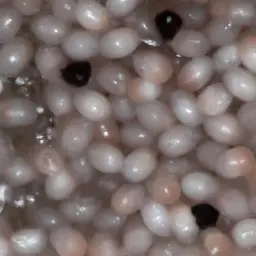Ever wondered just How Long Does It Take for Flea Eggs to Hatch? If you have pets, understanding the lifecycle of fleas is key to keeping your home flea-free.
In this blog post, we’ll explore everything from what flea eggs look like, time period and how to effectively prevent and treat flea infestations. Let’s find out what these little pests are all about and how you can stop them in their tracks.
Understanding Flea Eggs and Their Lifecycle
What Are Flea Eggs?
Flea eggs are super tiny, almost like a speck of salt. They’re white and sort of see-through, which makes them really tricky to spot either on your pet’s fur or in your carpet.
Here’s what you should know about these little eggs:
- Size: About as big as a grain of salt.
- Color: White and semi-transparent.
- Texture: Unlike the adults, these eggs aren’t sticky. They can easily tumble from your pet’s fur into nooks and crannies around your home.
The Flea Lifecycle: From Eggs to Adults
The life of a flea is pretty fascinating and happens in four stages:
- Eggs: These start off in your pet’s fur but end up in your carpets or sofa because they aren’t sticky.
- Larvae: After the eggs hatch, they turn into larvae. These little worm-like creatures hide from light, munching on organic debris.
- Pupae: The larvae wrap themselves in cocoons, turning into pupae. They stay in this stage until they sense a host is near.
- Adults: Finally, they emerge as adults ready to jump onto a host, feed, and start the cycle all over again.
How Long Does It Take for Flea Eggs to Hatch?

Factors Influencing the Hatching Time of Flea Eggs
The time it takes for flea eggs to hatch isn’t the same in every situation—it really depends on where you are and what the conditions are like.
Warmer and more humid environments are like a paradise for flea eggs, speeding up their development. If the air is warm and has a lot of moisture, you can expect those flea eggs to hatch much quicker.
On the flip side, in cooler and dryer conditions, it takes longer for flea eggs to become fleas. So, keeping your home cool and dry can actually help slow down a flea infestation by giving you more time to tackle the problem.
Average Time Frame for Flea Eggs to Hatch
Under the right conditions, flea eggs can hatch incredibly fast, sometimes in just two days. However, if the setting isn’t quite right—say it’s cooler and drier than fleas prefer—it could take up to two weeks for those eggs to hatch.
That’s why managing the environment inside your home can be so effective. By keeping your living spaces cool and reducing humidity, you actually slow down the lifecycle of fleas. This gives you more time to deal with them before they become a bigger problem.
Simple steps like using air conditioning and dehumidifiers can make a big difference in controlling flea populations.
How to Identify Flea Eggs in Your Home
Common Signs of Flea Eggs in Carpets and Pet Bedding
Wondering if those tiny specks in your carpet or pet’s bedding are flea eggs? Here are a few signs to watch for:
- Tiny white specks: Flea eggs look like small, white grains of salt.
- Location: Commonly found where your pet sleeps or frequents, like their bedding or your sofa.
- Excess scratching: If your pet is scratching more than usual, it might be due to fleas at various stages of their lifecycle.
Detecting flea eggs early can help you take quick action to prevent a full-blown flea infestation. Regular vacuuming and washing pet bedding at high temperatures are effective ways to reduce flea populations in your home.
Make checking these areas part of your routine, especially if your pet has been scratching more than usual or you’ve noticed more fleas around.
Treatment Options for Flea Infestations
Dealing with flea eggs effectively is crucial in stopping the cycle of infestation. Here are some tried and true methods to tackle the issue:
- Natural Options:
- Diatomaceous Earth: Sprinkle this natural powder where flea activity is high. It dehydrates the eggs and larvae.
- Essential Oils: Certain oils like lavender and peppermint can repel fleas. Use them safely around your home.
- Chemical Treatments:
- Insect Growth Regulators (IGRs): These chemicals disrupt the growth of fleas at various stages.
- Flea Sprays and Powders: Use these on carpets, furniture, and pet bedding to kill eggs on contact.
- Regular Cleaning:
- Vacuuming: Frequent vacuuming can remove flea eggs from carpets and upholstery.
- Wash Bedding: Regularly wash your pet’s bedding in hot water to kill any flea eggs.
Combining these methods increases your chances of eliminating flea eggs and keeping your home flea-free.
Always consult with your vet to choose the safest and most effective treatments for your pets and home.
FAQs Related to Flea Eggs and Their Hatching Time
To check if flea eggs have hatched in your home, look for tiny white specks that look like salt in your pet’s bedding, which are flea eggs. Also, keep an eye out for small black specks, which are flea droppings. This combination suggests active flea larvae that have emerged from the eggs.
Extreme temperatures are your best bet against flea eggs. Heat, especially, is effective—washing your pet’s bedding and any affected clothing in hot water can kill flea eggs. Cold temperatures might slow them down but aren’t as reliable for killing eggs.
After treating your pets, flea eggs already in the environment may continue to hatch for several weeks. This is because the treatments may not kill the eggs, which can survive and hatch based on their natural cycle.
Yes, flea eggs can hatch on human clothing, though it’s not very common. Fleas usually prefer furry hosts for their eggs, but if clothing is left in infested areas like pet bedding, it can certainly become a temporary home for flea eggs.
Flea eggs are visible to the naked eye, but they’re incredibly small and easy to miss. They are about the size of a grain of salt and can be seen as tiny white specks, especially when clustered together.
On dogs, flea eggs can look like tiny white flecks, similar to dandruff. These are often found in the dog’s fur, especially around the lower back, neck, and tail areas.
To remove flea eggs from your pet, regular grooming is key. Use a fine-toothed flea comb to comb through your pet’s fur, and wash your pet with flea shampoo regularly. This helps physically remove and kill the eggs before they can hatch.
Yes, vacuuming can effectively remove flea eggs from your floors and furniture. Focus on areas where your pet spends a lot of time, like their bedding and favorite resting spots. Vacuuming these areas frequently can help reduce the flea population.
Flea eggs may slow down their development in the cold, but they don’t necessarily die in winter. If your home is heated, the warm temperatures can allow flea eggs to survive and hatch normally.
If flea eggs are not treated, they can lead to a large-scale infestation in your home. The eggs hatch into larvae, which then become pupae and eventually mature into adult fleas, continuing the cycle of infestation.
Conclusion: How Long Does It Take for Flea Eggs to Hatch
So, how long does it take for flea eggs to hatch? It can be anywhere from a couple of days to two weeks, depending on the warmth and humidity of your home. By understanding the flea lifecycle and taking steps to prevent and treat infestations, you can keep your furry friends and your home safe from these tiny pests. Remember, regular cleaning and proper flea control treatments are your best defense against fleas.
Read More: Is Caviar Fish Eggs

